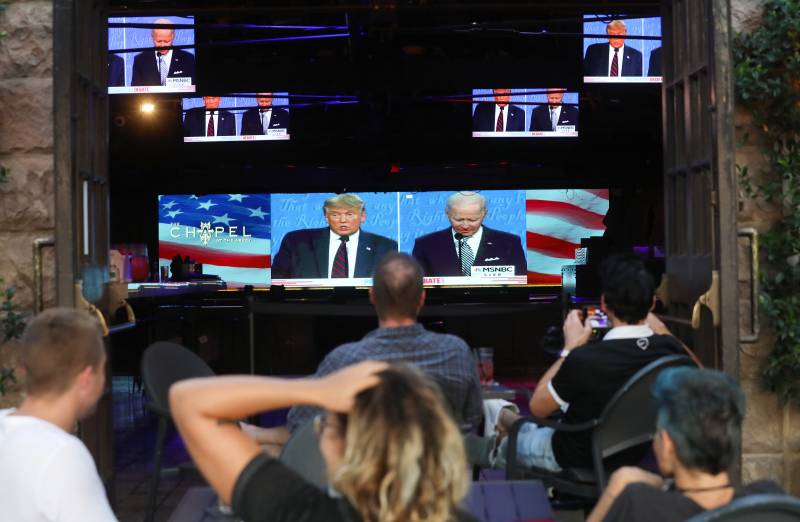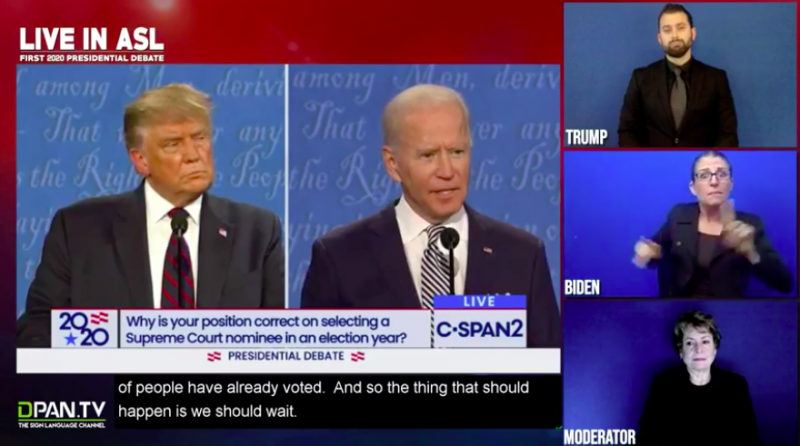After the first presidential debate on Sept. 29, there was one thing upon which the entire nation could agree. The event was, in the words of the New York Times, an “incoherent spectacle.” Non-stop interrupting and randomly hurled insults made it incredibly hard to follow and resulted in social media users asking, en masse, for future microphone muting.
Deaf Voters Deserve ASL Interpretation at All Presidential Debates

So imagine for a moment the difficult task of following something this chaotic without the ability to hear. That’s a challenge that 11 million deaf and hearing-impaired Americans face every time they try to watch a live event that’s assisted only by delayed closed captions. One of them, a first-time voter named Erin, hit TikTok the night of the debate to express her frustration. “There’s not an ASL interpreter. There’s nothing,” she said. “It’s not equal access and it’s not right.”
Given the importance of the event, not accommodating the one million Americans who use ASL as their primary means of communication is obviously a major and wholly unacceptable oversight. It’s made all the worse by the fact that just five days before the debate, a judge ordered the White House to start providing sign language interpreters at public and televised coronavirus briefings. As such, the need for ASL interpretation during all important political broadcasts should have been fresh in everyone’s minds. It wasn’t.
Prompted by the impossible task of trying to keep up via closed captions, Bridges For the Deaf and Hard of Hearing asked the nation for more equitable treatment on Oct. 1. The nonprofit organization uploaded a video to YouTube asking Democrats, Republicans and the Federal Election Commission to include ASL interpreters at the next presidential debate. “We are willing to provide the interpreters at no cost,” a representative said. “For the deaf community, American Sign Language—a language of the United States of America—is our first language and necessary for equal access.”
Given that this week’s Vice Presidential debate has no plans to incorporate ASL, that request appears to have gone unheeded, at least for now. Which isn’t terribly surprising given that deaf voters in America have never before been granted interpreters at a presidential debate. The unruliness that occurred on Sept. 29 simply shone a light on just how badly it’s needed.
So where can deaf voters turn for live interpretation of the debates, including Wednesday’s Vice Presidential one? DPAN.tv. The sign language channel livestreamed the Trump and Biden debate, with full ASL interpretation, via its Facebook page. Three interpreters appeared in a vertical stack on the right side of the screen, each individually translating for Trump, Biden and moderator Christopher Wallace, respectively. It was DPAN’s second time interpreting debates in a live setting, having done the same in 2016 when Trump and Hillary Clinton went head-to-head.

Perhaps DPAN’s example of how to successfully incorporate ASL into a live broadcast might one day inspire one of the major television networks to follow suit. Regan Thibodeau, who interpreted for Biden at the first debate, is hopeful. “This is history in the making,” she told the Press Herald. “I am so excited to help advocate for this to become the norm for standardized access in the media.”
Since 2016, Sign Vote—a coalition of 18 organizations for the deaf—has also been pushing for progress. It offers a space for the deaf community to catch up on election news, share opinions, and watch analysis of important campaign events. (Its 9-minute summary of the first debate, provided by The Daily Moth, packed a surprising amount of information into one short YouTube video.) Sign Vote’s end goal is to encourage greater participation by the deaf community in elections at every level.
In 2020, Republicans and Democrats opening up debate stages to ASL interpreters isn’t just the right thing to do—it’s the smart choice. Especially given that the 2016 election was decided by just 80,000 votes in three states. The representative from Bridges For the Deaf said it best in his campaign video last week. “Our community,” he said, “is perhaps more significant than has ever been realized.”
Follow DPAN.tv’s Facebook page for updates about the upcoming debate livestreams, including Oct. 7’s Vice Presidential debate. You can also view Sept. 29’s presidential debate in full there, as well as on the DPAN website.

